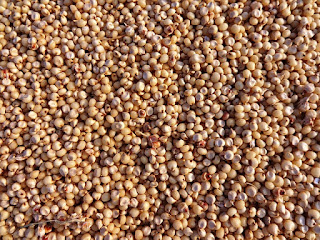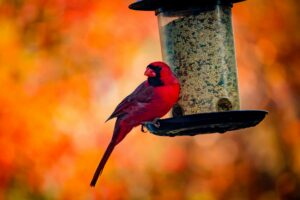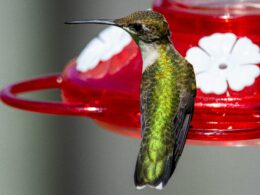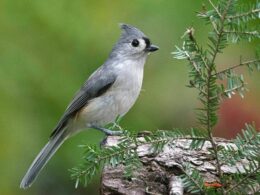Last Updated on January 8, 2024 by Greg Gillson
Many people give up on feeding birds. You can see those abandoned bird feeders in people’s yards. One major reason people stop feeding birds? “It’s just too messy!” So, how do you feed birds without making a mess?
You can feed birds without making such a mess by making these 3 changes:
- Change the amount of food you offer to only what the birds eat in a day
- Change the type of food you offer to hulled sunflower and other seeds
- Change the type of bird feeder to a tube feeder
Messy bird feeders are discouraging. Fallen seeds and hulls can kill the grass. They can draw insect pests. Messy bird feeders can even draw rats. Worse yet, if not cared for properly, bird feeders can actually spread diseases to birds we’re trying to help and enjoy.
I’ve lived in homes with ample backyards where bird feeding was simple. Any seed spillage just went to the ground at the rough back edge of the property. However, I’ve also lived in second-floor apartments and other places where feeding birds was not practical because of the mess.
Winter weather can blow bird seed hulls all over the yard, tip over feeders, and make a gooey mess of moldy seeds unless you clean up immediately. Let’s face it, going out regularly in winter weather to clean the bird feeders is not high on most people’s list of fun things to do.
Often, however, it is not the weather that makes the bird feeder mess. It is the birds themselves that are making the mess. They throw the seeds on the ground. Why? We’ll discuss several reasons why birds make a mess next. Then, we’ll explore what we can do about feeding birds without making such a mess.
If you’ve stopped feeding birds because of the mess, perhaps you can use these tips to start feeding birds again–this time without the mess!
 |
| Birds at a huge tube feeder. Image by GeorgeB2 from Pixabay |
Why do birds throw seeds out of the feeder?
There are several reasons why birds might throw seeds out of your feeder. Once we understand those reasons, we are in a better position to solve this common feeder problem. Only one of these reasons is accidental. In the other six cases birds are throwing seed from the feeder on purpose. Why would they do this? Read on.
1. Do birds eat the whole seed?
In general, no, birds do not eat the whole seed.
Birds eat the meat of the seed, the kernel. They discard the seed’s fibrous outer covering, the hull. If you examine the seeds under the feeder you may see that it is mostly the two inedible halves of the hull that have been tossed on the ground. This is true even for tiny seeds, they all have an outer covering that must be discarded before they reach the edible kernel.
Finches and sparrows “chew.” Their jaws move both up and down and also sideways. Thus they are able to use their bill and tongue and split the seeds in half, extract and swallow the kernel, and spit out the hulls. They sit on the feeder and chew and spit. Okay, it’s not really spitting, more just letting the inedible pieces fall from their mouths. These are the birds responsible for much of the mess.
Chickadees and nuthatches are not able to chew in this way. Thus, they take one seed at a time, such as a sunflower seed, and fly off with it to a nearby perch. They hold the seed with their toes against the tree bark to wedge it tightly. Then they pound the seed open with hammer blows of their beak. In fact, this is very action is the origin of the nuthatch’s name.
This type of “one seed at a time” and eating it elsewhere makes for a very neat bird feeder. Don’t we wish all birds were so non-messy?
2. “Kicking” is normal for some species
Towhees, Fox Sparrows, White-crowned Sparrows and some other ground-feeding birds habitually kick over leaf litter as they feed, searching under fallen detritus for a snack. They can’t help themselves when they get on the feeder. Kicking is how you eat. Off flies perfectly good seed—thrown from the feeder!
The Cornell Lab of Ornithology (source) calls this maneuver of the towhee the “double-scratch.” They quickly kick and scratch the ground, hopping forward and back with both feet at once. Then they look to see if they’ve unearthed any goodies to eat.
3. Not all seeds have mature kernels inside
The components of bird seed are harvested by machine. The plants are cut and the seeds separated from the stalk and leaves. By cutting all at once there will be some mature seeds and some not quite ready. Some seeds may not have anything in them.
Birds weigh and examine and test seeds to see if they have a nice meaty center, before they open them. If there’s not food inside, then they are discarded. There’s no sense expending energy on an empty seed. A bird who can’t figure out the difference won’t long survive.
4. Most birds don’t like every kind of seeds
While you may think you’re getting a great deal on bird seed, the birds may have other ideas.
Many of the cheaper mixed bird seed packages contain more than half seeds that most birds don’t like.
What do you do with food on your plate you don’t like? Yep, into the trash it goes. Birds throw out the seeds from the feeder they don’t want in order to get to the seeds they do want.
What does this mean? It is the equivalent of buying a whole bag of mixed bird seed, bringing it home and immediately dumping half of it out on the ground! No wonder it creates a mess!

5. Wet bird seed
Is wet bird seed bad for birds? Not at first, during or immediately following a rainstorm. Wet bird seed may clump together and be hard to eat. If it gets soaked through it may germinate and start growing. Birds will not eat germinating seeds. Birds will throw such “bad” seed out of the feeder. And it leads to the next problem if not quickly cleaned up.
6. Moldy bird seed
If seed sits in the bird feeder and stays wet it will become mushy and dank-smelling. That’s mold and bacteria growing.
Can birds eat moldy bird seed? They may try. And it may end up making them sick or killing them. If they don’t eat it, they may throw it out of the feeder, making quite a mess.
More than likely, though, they’ll abandon a feeder that has moldy bird seed, especially if it is wet.

7. Accidental spillage
Sometimes the seed is accidentally kicked out of a hopper or tray feeder. Or when pulling one seed from a tube feeder, another seed or two falls to the ground.
For all these reasons, birds may throw out seed from the feeder, making quite a mess. What do you do about it? Read on.
How do you make bird feeding less messy?
Using the reasons above for why birds might throw seed from the feeder, let’s look at the remedies.
1. Solution to: Birds don’t eat the whole seed
If it’s all the inedible hulls from the bird seed that is making bird feeding messy for you, then the solution is to feed only hulled seeds. The hulls are mechanically removed; you feed nothing but the kernels (sometimes called “hearts” or other confusing name).
You may also try offering birds something different–perhaps mealworms, raisins, suet or peanuts without shells.
2. Solution to: Kicking is normal for some sparrows
If ground feeding sparrows are kicking out seed and making your feeder messy, then the solution is to change to tube feeders and eliminate tray or platform feeders.
You will also want to eliminate large hopper feeders with large trays on them. These sparrows will then search on the ground under the feeders for seeds, helping you to clean up!
3. Solution to: Not all seeds have mature kernels inside
Like reason number 1, the solution to having empty seeds is to feed only the hulled seeds. There is actually a hulled bird seed mixture available of sunflowers, hulled millet, shelled peanuts and cracked corn–100% edible!
4. Solution to: There are some seeds birds don’t like
More than half of cheap mixed bird seed is red milo, a seed that most birds don’t eat. If you pay twice as much for bird seed that has no milo, you are actually saving money over the cheap stuff!
 |
|
Milo, the seeds of the sorghum plant–
a cheap birdseed filler that most birds will not eat.
Image by Vijaya narasmha from Pixabay
|
What bird do eat red milo? Chickens, pigeons, blackbirds and jays. Are those the birds you want at your feeder? Up to half your bird seeds could be the seeds of this grass.
Another grain most birds don’t eat is wheat. The birds that eat it? Chickens (quail and pheasants) and pigeons.
Each bird is going to have a favorite food and a least favorite food they’ll pick through to get to the good stuff. Thus, it is better to feed only one type of bird food or seed in each bird feeder.
5. Solution to: Wet bird seed
Make sure there is a mesh floor on hopper and tray feeders to allow air to dry out any wet seed. In some places winter equals the rainy period.
If cleaning feeders out weekly becomes too messy, or too much work, switch to tube feeders.
There are rain shields that protect from rain, but wind can still blow rain in. In this case, switch to a smaller feeder or, perhaps, don’t fill your larger feeder quite as full–if you have to throw away wet seed, it won’t be as much.
6. Solution to: Moldy bird seed
Throw it out. Clean your feeder with hot soapy water. Start over. Switch to a tube feeder during damp periods of the year. Don’t fill feeders beyond what birds will eat in a day. Replenish fresh seed every day at the same time, so birds will “put you on their schedule” as they make their rounds of all the neighborhood’s feeders.
7. Solution to: Accidental spillage
There will always be some spillage. Switch to a tube feeder, which is less messy. Messier ground feeding sparrows will actually feed on the ground under the feeders cleaning up much of the spilled seed.

Wrapping Up
You can feed birds without making a mess! We’ve talked about why birds throw seeds out of the feeder. And we’ve offered the following solutions to keep less seed from falling on the ground. It is possible to keep bird seed from going everywhere.
1) Put out less food
By putting out less food than your birds can eat in a day, you encourage birds to feed on the ground looking for spilled seed after the feeder is empty.
Make sure to refill your feeder every day, though, or birds will not return regularly. If there’s no extra food in your feeder it is less likely to go bad or attract non-bird pests.
2) Change the type of bird food you offer
The most popular bird seed blends that people buy are the least expensive. But these are filled with up to half seeds that birds don’t like. They throw it out and it creates a mess. Don’t buy bird seed that contains milo. It is actually less expensive to pay twice as much for bird seed that has no milo.
Most of the seed that birds do eat is the inedible hull. Hulls are entirely waste. Hulls are heavy. By weight, sunflower seeds are 35-40% hulls, waste, mess. Hulled sunflower seeds probably cost more than double that of seeds that have the hulls on. But there’s no mess with hulled seeds.
Also consider offering non-seed alternatives. Fruits and nuts (shelled) have been discussed. Suet is a good choice in cool weather.
3) Switch to a tube feeder
Some sparrows habitually kick and scratch the ground while they eat. If they’re on a tray feeder, seeds will fly.
Tube feeders are also more resistant to rain soaked seeds, reducing the chance for moldy seeds. Ground feeding birds will still feed on any spilled seeds under the tube feeder. A bonus to tube feeders is that large birds have trouble coming in and eating all the food at once.
Feed different foods in different feeders. That way birds will go to the feeder that has the food they want and they won’t be picking through and throwing away the seeds they don’t want.
Go out there. Give bird feeding another try. This time make it non-messy!
Frequently Asked Questions
What is the best bird feeder for no mess?
Determining the “best” no-mess bird feeder depends on several factors, such as the type of birds you want to attract, your budget, and the space you have available. However, here are some popular options known for their minimal mess capabilities:
1. Tube feeders:
- Benefits:
- Enclosed design minimizes seed spillage.
- Different sizes and perches cater to various bird species.
- Easy to clean and refill.
- Drawbacks:
- May not be suitable for larger birds or ground feeders.
- Smaller seed varieties might still spill from some models.
2. Mesh feeders:
- Benefits:
- Seed husks fall through the mesh, reducing mess on the ground.
- Often hold a larger quantity of seed, requiring less frequent refilling.
- Good for attracting smaller birds that can cling to the mesh.
- Drawbacks:
- Not ideal for larger birds or birds that prefer platform feeders.
- Some models can be challenging to clean.
3. Suet feeders:
- Benefits:
- Suet cakes are contained within the feeder, minimizing mess.
- Attract insect-eating birds like chickadees and nuthatches.
- Easy to hang and maintain.
- Drawbacks:
- Not suitable for seed-eating birds.
- May attract squirrels and other larger animals depending on the design.
4. Hopper feeders:
- Benefits:
- Seed automatically refills from a reservoir, minimizing spillage.
- Large capacity reduces refill frequency.
- Some models feature weight-activated closures to deter squirrels.
- Drawbacks:
- Can be expensive compared to other options.
- Some models can be challenging to clean and maintain.
- May not be suitable for smaller birds.
5. Window feeders:
- Benefits:
- Provide close-up viewing of birds from inside your home.
- Seed trays often have angled designs to minimize spillage.
- Some models have suction cups for easy attachment to windows.
- Drawbacks:
- Attracts birds to windows, which can lead to collisions.
- Window surfaces can become messy with bird droppings.
- Not suitable for all birds due to limited perching space.
Dealing with mess under your bird feeder can be a frustrating but common challenge for birding enthusiasts. Here are some ways to significantly reduce the mess and keep your birding area neat and tidy:
Choosing the right feeder:
- Type of feeder: Opt for feeders designed to minimize spillage, like tube feeders with small seed ports or mesh feeders that allow husks to fall through. Suet feeders also generally contain the mess within.
- Seed variety: Choose hulled seeds like sunflower hearts or nyjer, which produce less mess from discarded shells. Avoid cheap seed mixes often containing fillers and husks.
- Feeder size: Select a feeder size appropriate for the types of birds you want to attract to avoid overflowing and unnecessary spillage.
Placement and positioning:
- Location: Hang your feeder away from buildings, walkways, and patios to avoid droppings and seed mess on surfaces. Choose a sheltered location protected from strong winds that can scatter seeds.
- Height: Ideally, hang your feeder around 5-6 feet above the ground. This discourages ground feeders and squirrels from easily reaching spilled seeds.
- Distance: Place multiple feeders at a comfortable distance from each other to prevent overcrowding and competition, which can lead to more mess.
Cleaning and maintenance:
- Regular cleaning: Clean your feeder thoroughly every two weeks (more often during humid weather) to prevent mold and bacteria growth. Soapy water and a disinfectant rinse are usually sufficient.
- Seed tray/platform: Consider using a tray or platform beneath your feeder to catch any spilled seeds. Regularly empty and clean this tray to maintain hygiene.
- Ground cover: Place landscaping fabric or a similar material underneath your feeder to catch fallen seeds and husks. This makes cleanup easier and helps control weeds.
________________________________________________________________________________________________
Related Articles:
Bird feeder empty in a day–How often should you refill?
What types of bird seed attract the most birds?
End the mess of feeding wild birds! A rewrite of this article











this was a great discussion of messy feeders. it's going to change how i relate to my feeders.thank you!
Thank you for your kind words!
I buy sunflower seeds by the 50 lb., bag at the feed store. My concrete walkway around our in-ground pool (which was filled in with dirt YEARS ago) is always covered with the hulls, with many sunflowers actually sprouting up along the edges where seeds land. It’s a huge mess. This article was very informative!! I love all my birds, even took an injured Carolina Wren to a Rehabber when he came inside our screened in patio through the cat door, getting STUCK to a mosquito catcher, a very sticky cylinder, pulling off several wing feathers in the process of trying to get free!! So, I do all I can to keep them fed and sheltered. Thanks again for your help!
I live in an area of Memphis, TN that is heavily wooded, with dozens of acres of undeveloped woods surrounding our subdivision. Lots are an acre or more, with very large Oaks, Pines, Japanese Maples, Tulip Poplars, Honey Walnuts, Pecans, Magnolias, Hollies, Crepe Myrtles, etc. I provide several feeders that have been visited by Cardinals, Black-Capped Chickadees, Red-breasted Nuthatches, House Finches, Carolina Wrens, (they nest in my shed/greenhouse!), Robins, Mockingbirds, Goldfinches, Cedar Waxwings, Eastern Bluebirds, Ruby-Throated Hummingbirds, Woodpeckers, several species of Sparrows and Wrens. We’ve even had several make their way indoors, including a young Goldfinch! Ha! It’s an amazing presence but I can never get enough of watching them. I feel sure I’m leaving some out; I’ll try to add them next time!! This is a very interesting site, and I’m glad I found it.
You are welcome. Thanks for sharing, Kathy!
Thank you so much for visiting, Kathy! It sounds like you have a wonderful yard and neighborhood for birds.